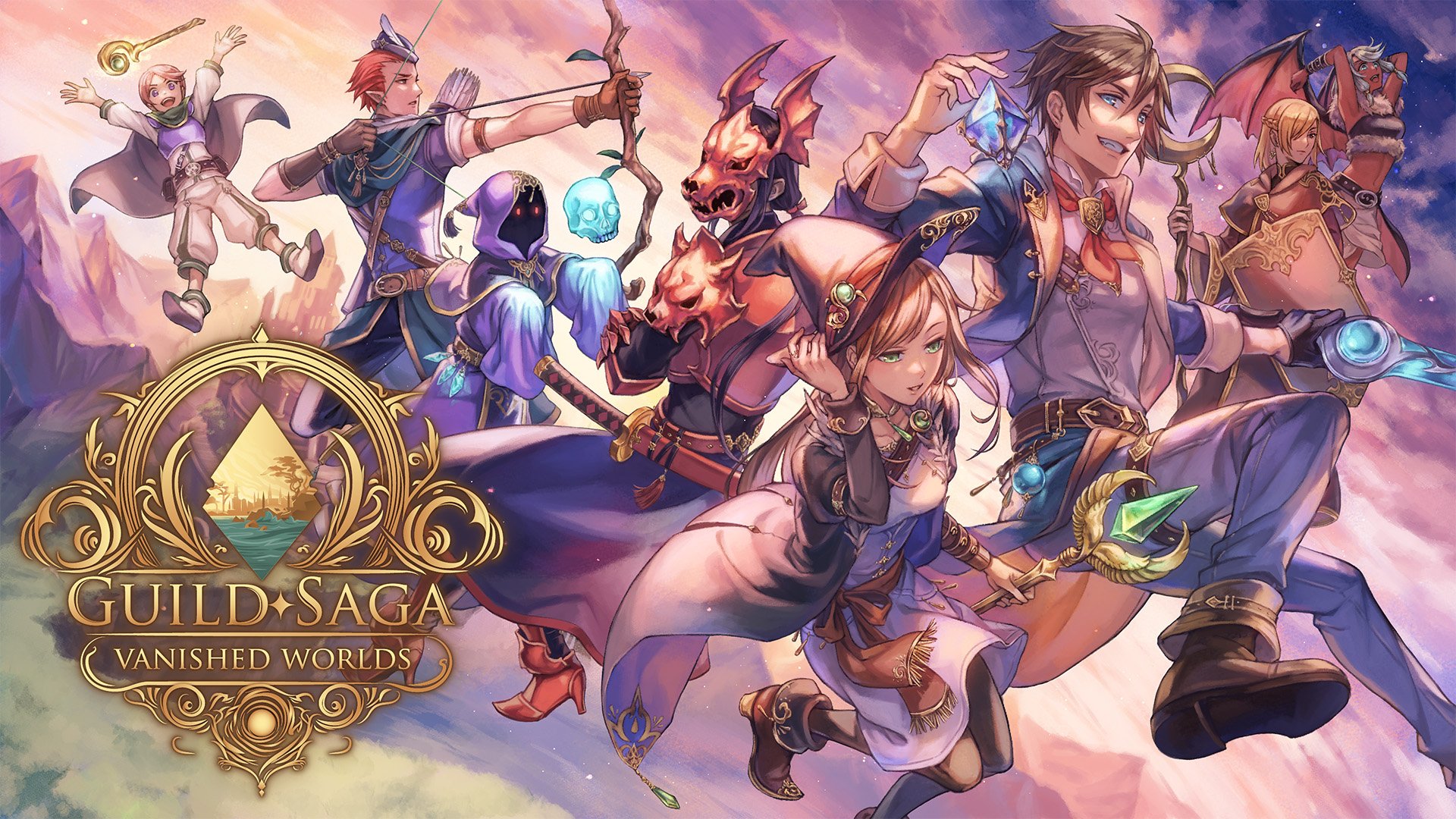What makes a good RPG? You’d probably hear a lot of people say something like “a deep and engaging story,” “fun and addicting gameplay,” or maybe something along the lines of “freedom of choice.” But for me, the thing that makes a truly great RPG is an immersive world brimming with unforgettable stories and memorable characters.
Stories that leave you satisfied but paradoxically create this insatiable hunger for more; characters that leave you with lasting impressions—strong enough that you start internalizing your encounters with them; a land filled with lore and mysteries that keep getting bigger and bigger as you go on through your adventure; and a world that houses all of these captivating experiences that you get to explore and enjoy at your own pace. And surprisingly, I must say. Guild Saga: Vanished Worlds checks all of these boxes.
Table of Contents
Overview
Guild Saga: Vanished Worlds is an isometric, tactical turn-based RPG set in the fantasy world of Aarde. The game features a retro style pixel graphics with an abundance of modern visual touches. The developers, known as Ocelot Technologies, took a lot of inspiration from classic Japanese TRPGs like Tactics Ogre and of course, Final Fantasy Tactics.
While the “visual style” and the “nostalgic feel” closely resemble the classical age of Japanese RPGs, its gameplay is more heavily inclined similarly towards Western CRPGs like Divinity: Original Sin and Pillars of Eternity. Which the devs also took inspiration from.
Honestly, when I first saw the screenshots and the Steam description for this game, I really thought that it was yet another generic, tactical RPG that’s banking on nostalgia, a somewhat bottomless well of income. Or at least that’s what a lot of other indie developers thought before they realized that nostalgia can only get you so far. But upon further inspection and actually getting to play the game, I’m happy to report that there is more to this game than meets the eye.
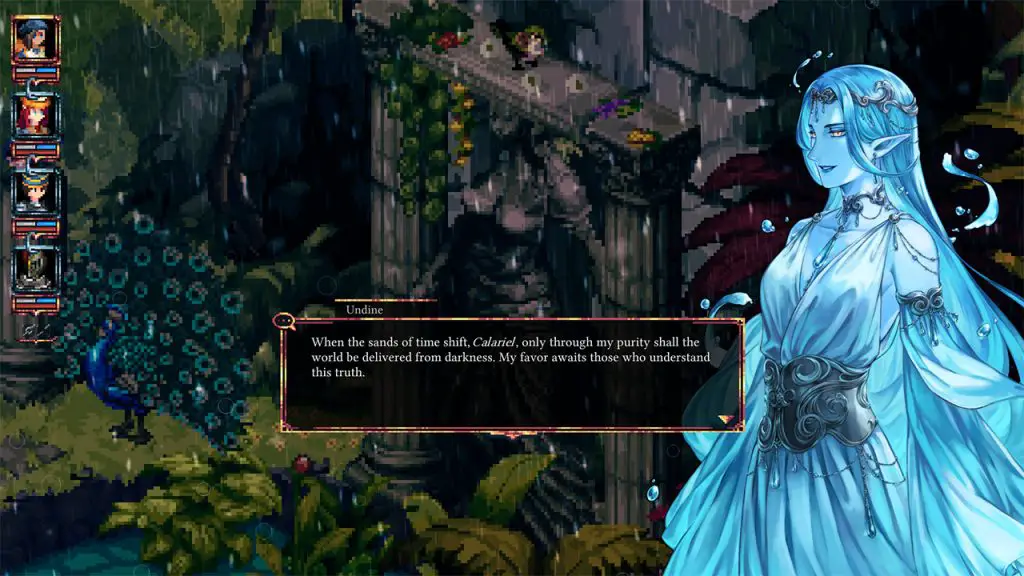
You see, while the developers took inspiration from other similar titles, they only took little bits and pieces from them as opposed to taking the whole cake and redressing it. It’s actually a pretty nice change of pace for a developer to just cherry-pick what they think their game needs and create an entirely original experience rather than taking the easy way out of copy-pasting well-loved video game mechanics and repurposing them for their “original” titles.
Story
Guild Saga: Vanished Worlds takes place in the fictional realm of Aarde, where an ancient entity stirs in the darkness, casting a veil of shadows across the lands and threatening all of humanity.
You play as a fledgling adventurer on your first mission for the Heroes Guild. While on the voyage to your destination, you find yourself and your Heroes Guild party members stranded on a nearly forgotten island where most of the story takes place.
Quests
Guild Saga: Vanished Worlds is an RPG that has a pretty interesting story structure. We can follow the story’s progress by viewing the quests tab where it suggests which quests are the main story ones and which are the side quests however, with how the game’s story is structured you’re better off treating all available quests equally important.
While there is an overarching storyline, the main quests and the side quests all contribute to the telling of that one story. This means that there are side quests that you have to finish first, or at least acknowledge the existence of in order to progress through the main story. Now, there are side quests that are completely optional, ones that will have no impact on the main story whatsoever. But it’s still better to do them anyway, considering how the game’s progression is designed, but we’ll talk more about that later.
Presentation
In terms of the story’s presentation, Guild Saga doesn’t really have cinematics so it tells most of its story with a perspective that’s consistent with its gameplay. The game unravels its narrative through dialogues between characters that’s exclusively presented in text, kind of like in CRPGs.
There are also some animated sequences, but they’re presented in the same isometric perspective as the gameplay. They’re really only there to augment moments and are never really used as the game’s main medium for storytelling.
Content
Guild Saga’s world is filled with a significant amount of stories and captivating moments that can be found in every corner of its world. From a somber story of a fallen deity to an intense showdown between good and evil in a town that’s on the brink of collapse to even a wholesome tale of a merry band of undead pirates.
The game is simply filled to the brim with such unforgettable moments along with remarkably memorable characters that have such profound perspectives that it’s hard to treat them as mere afterthoughts.
I truly relished the experience of witnessing the game’s story unfold, meeting its cast of merry characters, each featuring distinctive characteristics and personalities of their own, and discovering the secrets and vistas that Guild Saga had to offer.
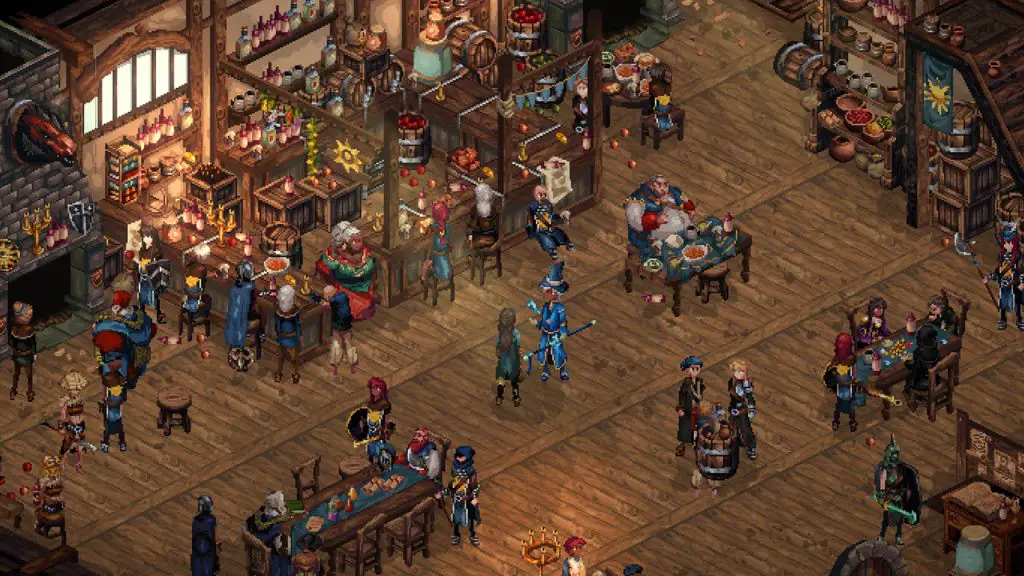
It’s actually quite rare nowadays to spot a small RPG that features a world that genuinely feels alive. So it was incredibly surprising when I found that here. I went into this game expecting a mediocre, run-of-the-mill experience. Instead, I witnessed a diamond in the rough, an absolute gem in the making.
Graphics
Guild Saga: Vanished Worlds features this retro 2D pixel art style that’s presented in an isometric perspective. While the core of its visuals are undoubtedly its pixel art style, the game also uses modern rendering techniques to further enhance its overall visual quality like considerable enhancements to its lighting and visual effects can be seen throughout the game, albeit, still following that pixel style standard.
Character Designs
The character designs are also something that’s pretty unique for an isometric game. Isometric Japanese RPGs or JRPGs often feature adorable, chibi looking characters for their playables and most NPCs while going ham on whatever style or scale for the enemies. Western CRPGs, on the other hand, are a genre known for their isometricism, and they feature realistic proportions for their characters. And Guild Saga’s art style feels like a blend of the two. The best of both worlds, so to speak.
The game has this generally cute and adorable stylized art style that makes use of proper proportions but isn’t afraid to exaggerate and add emphasis depending on the character. Allowing them to create a huge scale of distinction between the many different characters in the game. The realistic proportions, despite some characters looking very disproportionate to others, help in the suspension of disbelief that oddly results in a more immersive experience. I rarely found myself questioning why a certain character looks the way they do in the entirety of my almost 20 hours of playthrough.
Backgrounds
As for the background or the scenery, I have to admit that at first, I found it very jarring to look at. But in hindsight, maybe I really just wasn’t used to the visual style of the game. When I first started playing, my eyes kept darting around the map, desperately searching for something to focus on. It was honestly a messy, disorienting mess of pixels that made it hard to look for any containers to loot or even any NPCs to talk to. But oddly enough, that was only true for the first few hours of me playing the game.
I understand that it’s pixel graphics, but weirdly enough, because of how the levels are designed, it’s oddly really immersive. Well it’s not to the extent that I’d go as far as just stay in an area and bask in the ambience like what I’d usually do in a game like Skyrim or Fallout but, it makes me enjoy exploring new places and just going back and forth between quests and moving around the town doing mundane activities like crafting, buying items, and selling junk.
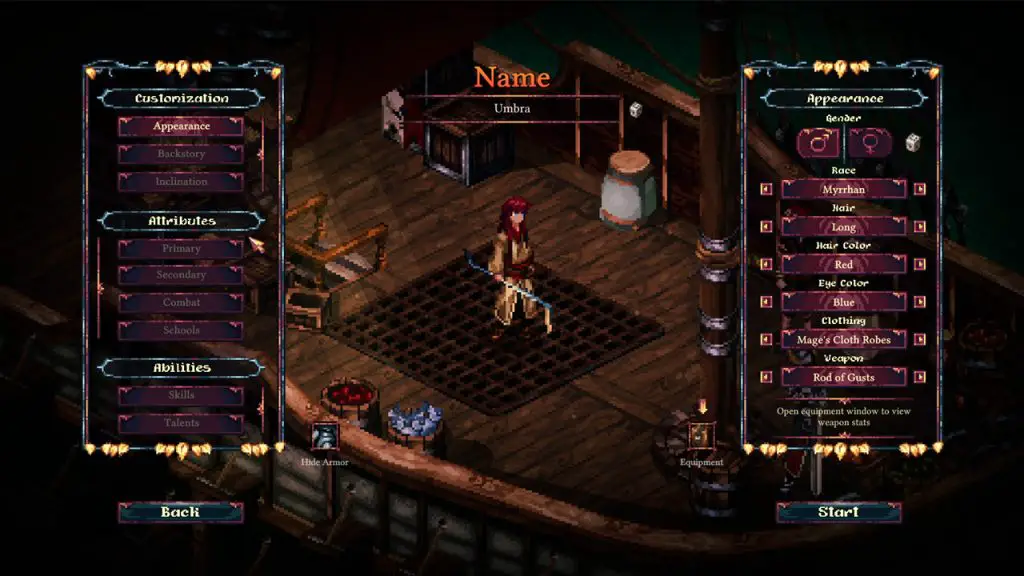
Character Creation
Before you start your adventure, you’ll first need to create your main character. After choosing a name, you can customize your character’s appearance. There are 5 races to choose from, but aside from changing your character’s skin color, I’m not exactly sure of its relevance in the game. Actually, none of the appearance options seem to give any benefits or detriments to your adventure apart from your starting equipment, but that’s something that’s easily replaceable once you’re in the game.
The backstory option lets you choose your character’s background, gives additional bonuses, and some even limits your playstyle. Take the “Pyromaniac” for example. It gives a plus 1 to Pyromancer but you will not be able to learn spells from any of the other three elemental schools of magic. The inclination dictates your character’s temperament, but I haven’t seen it impact gameplay.
With the character’s characteristics out of the way, you’ll finally be able to choose which attributes you’ll be specializing in, which will be helpful to whatever playstyle you choose to play, at least early on in the game. I won’t go too much into specifics, but there are 4 main archetypes or play styles you can play with in Guild Saga.
There’s Warrior, Rogue, Hunter, and Mage.
- Warriors prefer to get up close and personal with their enemies to dish out a lot of weapon damage.
- Rogues dart around the map, placing traps to create openings and dealing deceptive blows to weakened enemies.
- Hunters shoot arrows from across the map, dealing damage to foes from a safe distance.
- Mages utilize the many different elements of magic to always have the upper hand on the battlefield.
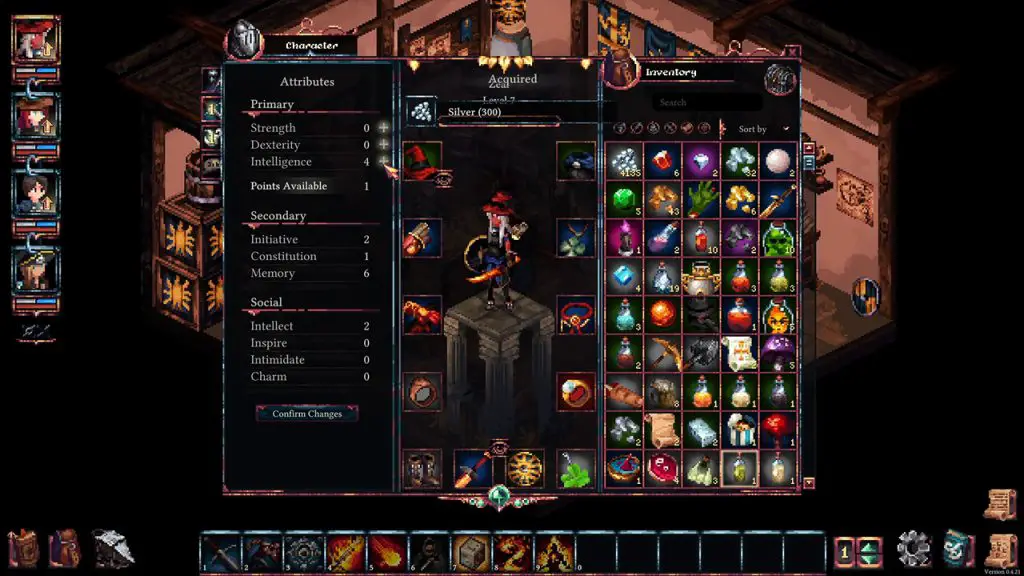
While these are the 4 main playstyles that you’ll mostly be revolving around in, you can definitely create your own builds as you see fit. I myself am running a Pyromancer Magic Swordsman, which is basically playing as a mage with a sword slashing away at enemies with my flaming lightsaber of doom, with the occasional force powers.
You can also choose which schools of magic and martial arts to specialize in, what abilities to start with, and a special talent that’ll help you on your journey.
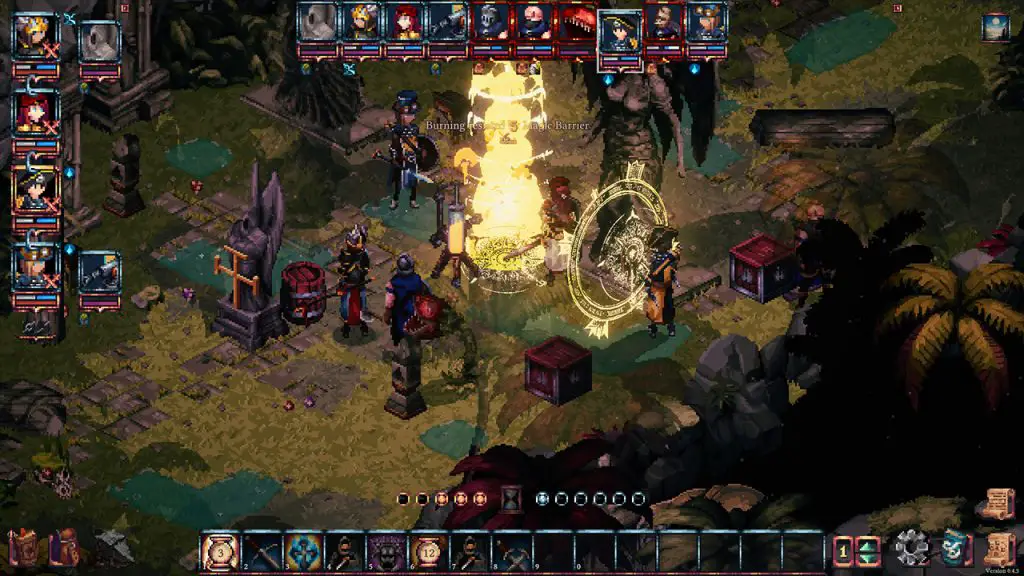
Gameplay
Seeing as Guild Saga has an anime-like stylized look to its game you’d probably imagine gameplay that closely mimics the classic Japanese TRPGs of the bygone days. But despite the game looking closer to Japanese RPGs, Guild Saga: Vanished Worlds actually plays closer to CRPGs like Baldur’s Gate.
To be exact, an extremely toned-down version of a CRPG, a CRPG lite if you will.
That’s because while the game offers a ton of choices when responding to particular events, only a handful of them have any real semblance of consequences, and even then, they’re entirely inconsequential to the bigger picture. You’ll still be following the exact same story; only the characters may make snide remarks at you if you choose to be someone who’s very obnoxious. At least, that’s the case as of writing.

The game will be released in early access, and development is still pretty much ongoing. So we might see a lot of changes, a lot of revamps, and a lot of improvements to the game in the future. The only real consequential things that I have seen in the game so far are characters that you meet only temporarily and who have the risk of dying. This may leave you empty-handed after an encounter, as opposed to if they get to live, where you get some additional rewards.
Thankfully the game lets you save scum the hell out of it, so in doing so, you’re pretty much in full control over the fate of your party and anyone else you meet.
Exploration
When you’re not out fighting your battles in Guild Saga: Vanished Worlds then you’re probably walking around the map, exploring, looting every container that you may find, and talking to every NPC you encounter.
Exploration is a huge part of the game, and ignoring this is ill-advised. A lot of the things you need to progress the story or even just to stay ahead of your enemies can be found while exploring and looting. For the game’s quest and story progression, you pretty much have to talk to every NPC in order to start most of the quests, especially the side quests. Which, according to what I said earlier, are pretty much as important as the main quests in this game.
While you can technically ignore most of them, you’ll still be missing out on a lot of contexts, on some much needed character EXP, and, most importantly, the money and rewards that come with completing that quest. And I’ll explain further why this is so late.

See, exploration aside, talking to NPCs is a very, very large part of the game. Once I reached the town called Gladeheim, I pretty much ended up just exploring the town, talking to NPCs, reading their dialogue, listening to them yap and all that stuff, and that’s basically what I did for around 2 hours.
Note that I played through the game twice, and the 2 hours I talked about was on my second playthrough, where I already knew what I needed to do, what I needed to get, and where I needed to go, but it still took me that long to complete all of the quests related to the town that didn’t need me to go to the next area. So, for a first playthrough, I’d say that you’ll probably spend around 3 to 5 hours tops in this stage of the game.
I think it’s best to treat this game as a CRPG first and foremost, and dialogue and exploration are equally important in combat. Some of the quests have progressions that aren’t exactly linear. Some of them even only make sense after you’ve done some of the other quests first. So expect a lot of activities that’ll lead you back and forth to different areas of the game.
Nevertheless, I was actually pleasantly surprised by what the developers concocted with this one.

Combat
Combat in Guild Saga is a pretty simple classic turn-based combat where each unit on the field takes turns performing their actions. You get to control an entire party of heroes that you can freely build and customize.
Something I really liked when playing this game is right off the bat; your character’s specialization feels weighty and purposive. Spells actually feel useful and apply certain effects compared to normal attacks that have the sole purpose of dishing out damage.
A lot of classic Japanese RPG inspired games make the mistake of making abilities function the exact same as the basic attack or the healing potion just with varying degrees of damage.
Some spells also react to certain elements on the battlefield which can either create or destroy hazards on the field. For example, lightning spells when used on a puddle of water would cause that puddle to be electrified and any unit that passes through the puddle becomes paralyzed.
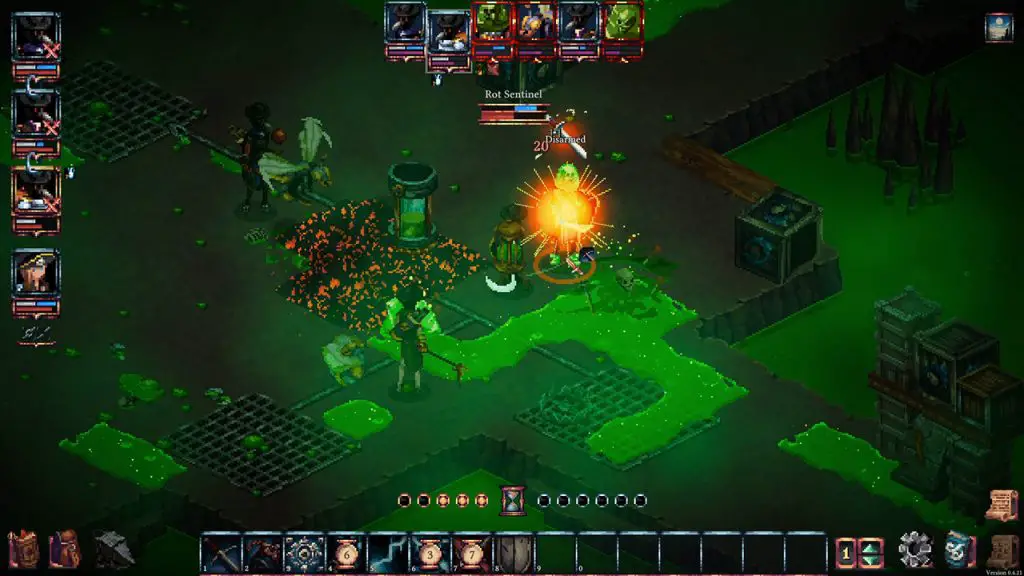
There are also entire levels built to fit a theme, which makes it much harder for players who came unprepared but, inversely, makes it super easy for players who planned ahead. But I think the best thing about combat in this game is its handcrafted encounters, designed to be challenging but never tedious.
One of the problems I’ve encountered when playing other indie TRPGs is that they define difficulty as enemies dealing greater damage and having insanely more health. This ends up being a tedious endeavor that makes you wish that it would end, but that’s never the case in Guild Saga.
Even with its big, drawn-out battles, the game never felt tedious. In fact, the hardest and longest battle that I experienced in my playthrough was also the most fun and the most rewarding. Overall, the combat and encounters are challenging, but they are all fun challenges.

Crafting
You can also do some crafting and cooking but so far, I haven’t found any recipes for gear, only recipes for cooking food. While the game hints at you that crafting is a big part of it, that’s so far from the truth. The only time I found crafting useful in my entire playthrough was when cooking raw meat to turn them into items that sell for 4 silver as opposed to 2 silvers. Other than that, there’s really not much to it. But the game is still in early access, so we might see some revamping of the crafting in the future.
Progression
In Guild Saga, enemies that you have beaten will never respawn, meaning you can’t keep grinding them for more resources. Basically, once you’ve defeated and looted them, that’ll be all you get from them. Loot crates also never refresh, so everything is essentially a one-time loot. This means that you’ll be juggling a limited amount of resources for the entire duration of your adventure. I usually just sell the stuff that I don’t really have any use for. Non-potion food items and materials were just junk to me so I just traded them in for more money.
This means that you can’t just buy everything you want; otherwise, you’ll be locked out of getting better gear and items later in the game.
I wish there was a dungeon or an activity that lets you repeatedly earn money or items by slaying enemies. But even then, I also like the idea of having to work with what you have, where you have to choose carefully from the items that you need and the ones that you can afford to disregard.
This is the reason why I kept blabbering about why you should just do all the quests and loot everything as you explore. Because once you face a wall and you’re out of materials, I fear that the only way to move forward is to start fresh and try again.

Verdict
Guild Saga: Vanished Worlds is an amazing surprise to the world of RPG gaming by Ocelot Technologies. Researching the game at first didn’t give me much faith in the game, especially when I found out that it’s basically cut from the same cloth as an ongoing NFT project. But I gave it a chance because, apparently, it’s a stand-alone title that has nothing to do with its Crypto-based counterpart aside from sharing the same IP, of course.
What awaited me was a pleasantly enjoyable experience that is surprisingly rare, even in big-name RPGs, let alone indie RPGs of recent years.
The world of Guild Saga is filled with stories, memorable characters, and unforgettable moments that despite playing the game for a second round, I was still able to find some things that I somehow missed the first time around. The combat, while not exactly revolutionary, is more than adequate for the experience, offering an engaging and satisfying experience even in its most challenging encounters.
Guild Saga: Vanished Worlds is now available for Early Access on Steam. As it is still in early access, we can expect that the game is still subject to changes, and it seems like only a fourth of the content will be available at launch.
But despite releasing in early access and only having a portion of the game available, I was still able to squeeze out around 10 hours of playtime in one playthrough which is still a considerable amount of time in an unfinished game.

